Movies that depict the Civil War, you will often see a camp scene at some point during it. It might be early in the morning just as a hazy, blue dawn is creeping its way across the sky, or in the evening when men huddled around campfires and talked low about their fears for the coming battle. Typically, these scenes have rows of white tents where soldiers slept and spent their down time between battles. While there’s some validity to these Hollywood images of Civil War shelters, the truth is more varied and demonstrates the resourcefulness of the common soldier.
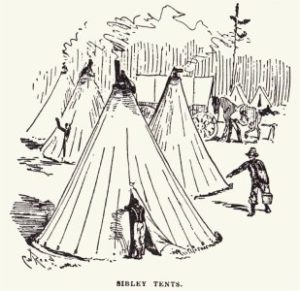
At the start of the Civil War Union soldiers often used the Sibley tent. This tent was invented in 1857 by Henry Sibley. Sibley, a West Point graduate, who explored out west and was inspired by Native American teepees. This was a very large conical shaped tent. It is eighteen feet in diameter, and twelve feet high with a support pole in the center that sits on a tripod. They could only house about a dozen men in close quarters. These tents could also raise and lower from the ground to provide better air flow. The top of the tent had a round opening. This opening allowed for ventilation and a stove chimney. In rough weather a flap could be pulled over the opening to protect the inside. When soldiers were not using a stove inside the tent they built campfires on the floor. The Sibley tent began to disappear from camps in 1862, due in part to the need for mobility as the big campaigns began. The tents were also expensive and wagons were better utilized for carrying rations and ammunition.
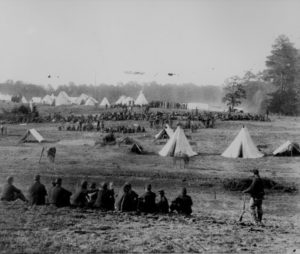
Sibley tents in a camp scene. Guarding Confederate prisoners. Courtesy: Records of the Office of the Chief Signal Officer, 1860 – 1985
The next style, made popular by the Romans, are wedge tents. They are most common in those historical films. Simple and easy to piece together, a wedge tent was a canvas tent stretched across a six-foot-long horizontal bar with two vertical supporting bars in the front and back. These Civil War tents could sleep up to six men. If five or six soldiers were sharing the tent they would have to spoon each other and turn over at the same time. It could fit four soldiers comfortably. Many soldier accounts describe this arrangement as ideal and not the least bit awkward.
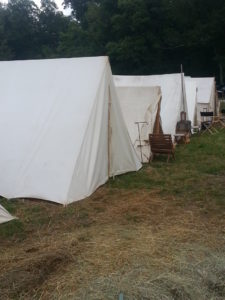
Modern example of the wedge tent.
Hospitals modified the wedge tent to include four upright walls, raising the roof and considerably expanding the dimensions to house wounded soldiers. These were so large that men could walk around upright in them. They could hold up to twenty patients or men. This style also used for officers or higher-ranking soldiers. There would be a corridor down the center of the tent with cots on each side for the patients. When a larger tent was needed soldiers would join two of these tents together doubling its size. But like the Sibley tents, it wasn’t practical for every six men to have a tent for themselves, or for every commissioned officer to have one either. As the war progressed, the wedge tent, like the Sibley tent, became too difficult to move around and thus was retired from common use. They were still used in training camps or in the areas where generals and higher commanders took their leisure.
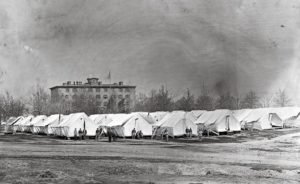
Medical tents at Arlington. Courtesy: Library of Congress
The last, most common style, was the “Dog Tent” or “Shelter tent”. These popped up almost as soon as men were constantly on the move. They had no time or material to construct barracks, the Sibley tent was too expensive, and the wedge tents were just too much for the wagons. So, men resorted to duck cloth or rubber blankets – nothing ever as sturdy as canvas – to make their shelters. These “half-shelters” were five feet long by four feet wide, and had loop holes at the bottom for stakes.
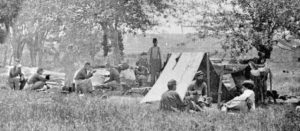
Sitting outside their dog tents.
The men were expected to carry these “tents” themselves and often joined forces to try and make something bigger. The two half-shelters were supported by rifles with their bayonets attached. The rifles were stuck vertically into the ground, one in front and one in the back of the tent. Again, another situation of forming these bonds of necessity between soldiers during their time in the service. If it was good weather soldiers typically would not use their tents. Instead they would sleep out under the stars with just their blankets. The last thing a tired soldier wanted to do was take time to setup a tent if it really wasn’t necessary. If the weather was bad, or it was going to get bad, they would set their tents up. Soldiers would dig a ditch around their tent to drain rainwater away.
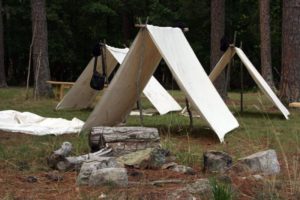
“Dog” tent replica
Whether they were in the Sibley tents, wedge tents, or dog tents, the soldiers would pass their time doing just about anything to fight the boredom. Reading, writing letters, playing games, smoking their pipes, mending their clothes, playing music, or just socializing. The comradery felt by the men when building shelters together helped unite them as well during battles. These shelters may not have been home but they did help the men feel a little less homesick.





